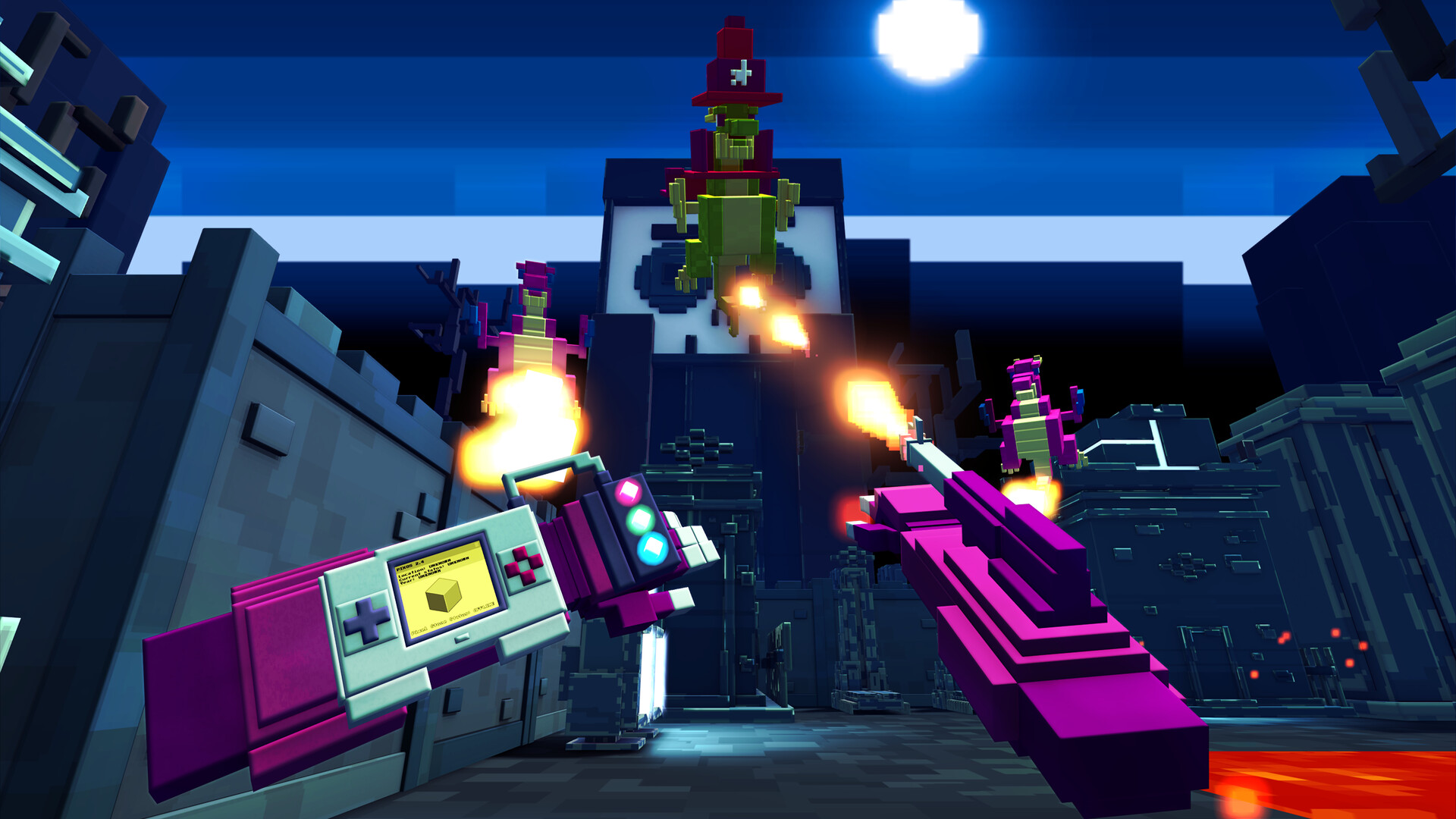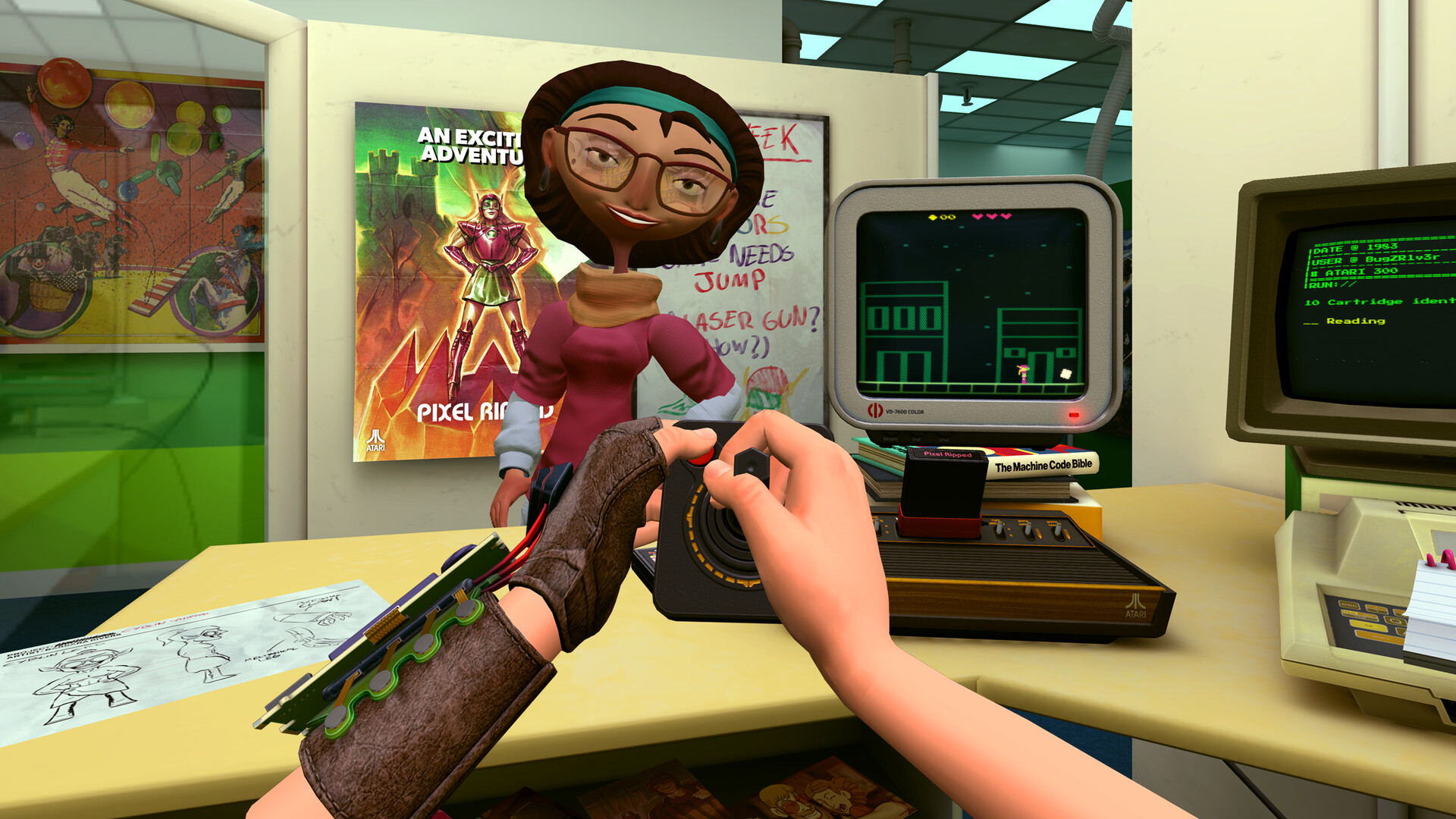
The latest celebration of Atari’s 50 year long history is a VR game that sends you back to the 70s and into the games themselves.
Pixel Ripped 1989 took a VR-infused nostalgia trip into ’ history, allowing you to play games on a virtual handheld, whilst trying not to get caught by your mum or teacher. Its sequel, Pixel Ripped 1995, was more sophisticated, telling a coming of age story about the game’s protagonist, and the medium itself. The latest outing sends you even further back in time, to Atari in the 1970s.
You play as the appropriately named Bug, a developer tasked with getting rid of glitches besetting Atari’s nascent games catalogue. In keeping with the mores of the franchise, that involves not only playing those games but also an artful blend of realities, as parts of the games escape the confines of the screen and seep into your office. That or suck you directly into their blocky, neon-hewn worlds, where you become game hero Dot.
If all that sounds a bit confusing, don’t worry, because while Pixel Ripped 1978 does have a plot, it’s far more interested in action and silliness than deep storytelling. In your office at Atari there’s a VCS console on your desk and a primitive CRT monitor balanced on top of a stack of coding manuals. You plug in a game cartridge, grab an authentically recreated Atari joystick with both your virtual hands, and off you go.
The VR versions of first generation Atari games are generally rather good, with their basic feel and sound effects captured perfectly; their ruthless difficulty level ameliorated by frequent checkpoints that help prevent any of its levels reaching the tearing-your-hair-out stage. Items you find in these brief playthroughs then come in handy as you take on Dot’s role, beaming yourself into the games to take them on from the inside.
Using a device on your left wrist, that looks suspiciously like Nintendo’s unintentionally hilarious Power Glove peripheral, you stand on a purple glowing portal, touch your glove, and enter the game. At that point, the blocky characters and brightly coloured backdrops suddenly take on the scale of the world itself. You’ll still talk to everyone by pressing ‘X’, their speech appearing in neat text boxes next to their heads, but now you have to complete their errands in person.
These mostly revolve around simple fetch quests and shooting, using a gun attached to your right hand. Just point and hold down the trigger to unleash a slow but steady barrage of outgoing rounds, to gun down roughly drawn dragons and ground-based clowns and robots. Larger enemies are total bullet sponges, and none of them exhibits much personality, but these sections are usually mercifully brief.

You’ll then be chucked back into the Atari office or into a flashback to Bug’s early life, in scenes that blend on-screen play with action from the world around you. In one memorable sequence your game of Breakout, played on a TV designed to imitate Sony’s early Trinitrons, bursts out of the screen, forcing you to take pot shots at the baddie with rolled up balls of paper from the table in front of you, while you continue to play Breakout with your other hand.
Some of those meta moments work better than others. At the Atari HQ, as you play through the 2D games you’re debugging, you’ll regularly have to toss back an American football hurled over your cubicle’s walls, answer your desk phone, or feign interest in the office party going on around you – by putting on a rubber mask or taking a sip of beer. Those micro-tasks aren’t much fun, and especially after the third or fourth time, not the least bit amusing.
That problem extends to the games themselves. While the 2D versions are often surprisingly playable, despite their simplicity, levels where you enter the 3D game world are generally extremely dull, their bright colours only adding to the disconnect between visuals and actual entertainment. There’s a pervasive sense that the overarching experience adds up to a lot less than the sum of its parts.
That’s not to say there aren’t good moments, with the game shining its brightest during its real-life bug squashing levels. Here you’ll be playing a 2D game, pausing occasionally to bash the side of your monitor to get rid of interference, or to knock the bugs from the screen into the air around you, where you swat them to get rid of them for good. That lightly hectic mix of old school platform game, with elements emerging into the room around you, works well, and it’s a shame the game can’t sustain that level of quality.
As it is though, too much of your time is spent enduring wearyingly crude interactions or listening to banal and frequently repeated interjections from other characters. It’s also one of a very few VR titles that made us feel queasy, although that is admittedly with its comfort settings turned off. The net effect is a game that’s quirky and high concept, and that makes interesting use of VR, but is just not particularly fun or engaging to play.
Pixel Ripped 1978 review summary
In Short: Extreme video game nostalgia enters the world of VR but the novelty can’t excuse the sub-par gameplay and repetitive humour.
Pros: Amusingly accurate recreations of games from the golden age of Atari, plus an audio-only cameo from Atari founder Nolan Bushnell.
Cons: The 3D VR versions of games aren’t much fun and there’s far too much repetition by NPCs trying to be funny. The games interacting with the wider world often falls flat.
Score: 5/10
Formats: PlayStation VR2 (reviewed) and PC
Price: £19.99
Publisher: Atari
Developer: Arvore
Release Date: 15th June 2023
Age Rating: 7
Email [email protected], leave a comment below, , and .
Follow Metro Gaming on and email us at [email protected]
To submit Inbox letters and Reader’s Features more easily, without the need to send an email, just use our .
For more stories like this, .




















